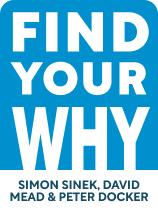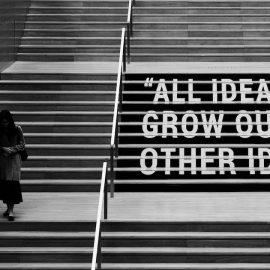

This article is an excerpt from the Shortform book guide to "Find Your Why" by Simon Sinek, David Mead, Peter Docker. Shortform has the world's best summaries and analyses of books you should be reading.
Like this article? Sign up for a free trial here .
What is the best method for finding fulfilling work? How does understanding your life’s purpose lead to fulfilling work?
According to motivational speaker and author Simon Sinek, taking the time to examine your life’s purpose will lead to finding fulfilling work. Sinek provides a proven method for discovering your Why, or purpose, and shows how purpose-driven people lead happier lives.
Keep reading to find out Sinek’s steps for finding fulfilling work through living a purposeful life.
Finding Your Why
Purpose-driven people are more successful at finding fulfilling work, and they contribute more to the world around them, according to Simon Sinek, best-selling author, coach, and popular TED Talk speaker. Find Your Why distills Sinek’s theory and his experience working with organizations and individuals into a workbook you can follow to discover your own purpose and strengths, or those of your organization.
According to Sinek, “finding your Why” means finding the single core belief that inspires you to do the work you choose to do and be the person you want to be in all spheres of your life. He believes every individual and organization has a purpose, though not everyone has discovered theirs or put it into words.
When you know your purpose, you can find work that fulfills you—that is, work that matters and makes you feel that you’re part of something bigger. Sinek believes everyone, no matter their role or status, deserves to find fulfilling work. (Shortform note: Sinek draws a distinction between fulfillment and happiness, unlike traditional career advice that often conflates the two or sees them as operating in tandem. Fulfillment is lasting while happiness fluctuates. Additionally, Sinek’s understanding of fulfillment as a human need is in line with long-standing theories from psychology. Psychologist Abraham Maslow theorized that humans have five basic needs, including self-actualization, or fulfillment of our potential.)
Example: A Personal Purpose Statement
This example of a personal purpose statement shows how each characteristic contributes to the effectiveness of the overall statement: “To help women unleash their inner power to create a life in which they feel fulfilled, inspired, and empowered.”
1. It’s a single sentence, so it’s easy to remember and use to make decisions.
2. It’s clearly focused on the impact the person seeks to have.
3. It’s meaningful and it declares real goals and actions so the writer can easily know which opportunities or ideas are aligned with her purpose, or Why.
4. However, it’s not so specific that it limits her to only one type of work. It would be a constant whether she’s at work, in civic or volunteer work, and even in her interactions with friends and family. She could be a life coach for women, a venture capitalist who seeks out women-led ventures—or, a mother or friend with a knack for empowering girls and women.
Determining Your How
The process of identifying your How, or methods, is the same for individuals and teams:
First, group similar themes until you’re left with no more than five. (Remember not to use the themes you already wrote into your purpose declaration) Each of these remaining themes is one of your “Hows,” so you will have around five practices that characterize you, and together describe how you put your purpose into action. Sinek recommends stating your How in actionable language that is easy to understand. Then, elaborate on each How to make it more concrete by adding clarifying statements.
For instance, if a How states “we build safe communities,” you could add the following clarifying statements:
- “We look out for our community members.”
- “We create safe spaces where everyone belongs.”
- “We seek opportunities for connection.”
(Shortform note: Besides helping you understand which situations bring out the best in you, writing down your How is an opportunity to identify myths you might be holding about yourself. Among the themes you identified, you might have included myths about your personality—traits you believe you have and that even shape the way you tell stories about yourself but turn out to be inaccurate. Thinking through your identified strengths and elaborating on them to make them more specific is an opportunity to shine a light on these myths and root them out before trying to find fulfilling work.)
Sharing Your Insights With Others
To find fulfilling work, Sinek suggests talking with friends to check whether your purpose statement is an honest expression of your best self. Ask them what they specifically value in you as a friend. Their answer should reflect the effect you have on their life and echo your purpose statement. If it doesn’t, go back to your discussion partner, and discuss whether your friends have raised any themes worth exploring.
(Shortform note: The authors suggest a collaborative approach to validating your purpose, but this can apply to your life beyond sharing your purpose. In Designing Your Life, Bill Burnett and Dave Evans argue that since you live in collaboration with others, you should also design your life collaboratively. One way to do that is to create a team of close allies and influential people in your life who you share your life project design with and who give you feedback and support.)
Additionally, talk to the people you interact with often—both at work and in the other spheres of your life—about your Why and How. This will help them understand your motivation and strengths which, in turn, will help you collaborate more effectively with them because they’ll know where you’re coming from (your Why) and what skills you can contribute (your How).
(Shortform note: Sharing your Why, or purpose, and How, or methods, with colleagues can contribute to a culture of Radical Candor, a management style that focuses on supporting people through personal and professional problems. If you’re a leader, you can encourage your employees to share their Why and How with you. Then you can follow Kim Scott’s advice to support their ambitions and growth by analyzing their performance and growth trajectory and giving them the kind of feedback and challenges they need.)
The final step to finding fulfilling work is leading with your purpose instead of your How or What when you introduce yourself to strangers. For instance, before discovering your Why, you might have introduced yourself this way, “Hi, my name is Jane. I’m a community manager, specializing in building vibrant online communities around social media influencers.”
Now, you can make a powerful pitch: “Hi, my name is Jane. My purpose is to build vibrant online communities around leaders and tastemakers so that people can find their tribes and thrive together.”
(Shortform note: Introducing yourself to strangers can be nerve-wracking, especially if you’re sharing something personal like your purpose. To overcome nerves when talking to strangers, follow the tips Keith Ferrazzi outlines in Never Eat Alone, including emulating an extroverted role model in social situations, joining clubs where you can meet people who share your interests, and setting small targets for yourself, like introducing yourself to one new person every week.)

———End of Preview———
Like what you just read? Read the rest of the world's best book summary and analysis of Simon Sinek, David Mead, Peter Docker's "Find Your Why" at Shortform .
Here's what you'll find in our full Find Your Why summary :
- Simon Sinek’s steps to understanding and living your purpose and your organization’s
- How to create and write your purpose statement
- What to do after you find your Why: Determine your How






